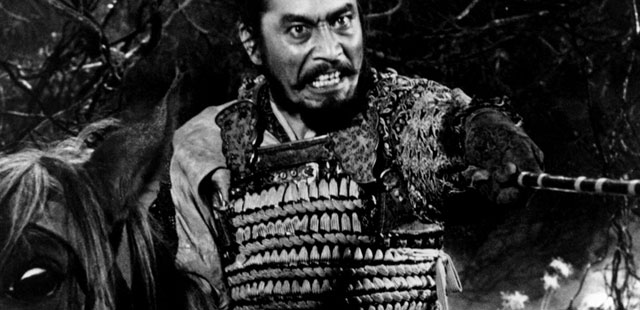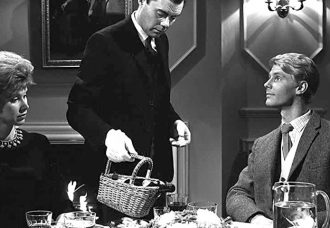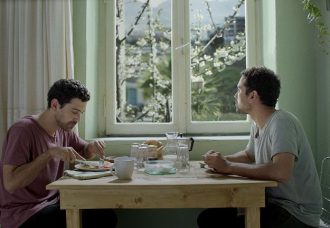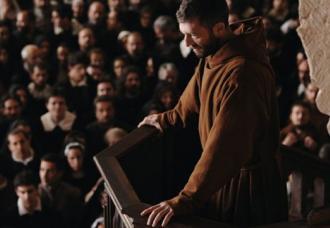‘Macbeth’ was written sometime in between of 1587-1606. William Shakespeare wrote multiple plays on the issue of succession during this time as Queen Elizabeth I was growing old and had no heir. In the end, her nephew, James I of Scotland succeeded her, another probable reason for Shakespeare to look at Scottish politics for his content. Meanwhile, Akira Kurosawa’s film, Throne of Blood was made in 1957, with the ever-pervasive influence of technology very much present in the film – the use of wind and smoke machines to create the foggy atmosphere and jump cuts when Washizu confronts the witch the second time and she seems to appear in different disguises. While reading ‘Macbeth,’ we’re limited to our imagination that’s stimulated from the text. The cinematic adaptation opens up a variety of interpretations from the way the actors decide to perform, to the music and deliberate camera angles, to the modern art direction.
‘Macbeth’ is a supernatural tragedy about a greedy Scottish general who climbs the political hierarchy through means of deceit and murder all initiated by the three witches’ prophecy with a tragic ending due to an unlucky coincidence. Kurosawa’s Throne of Blood is less of a faithful adaptation of ‘Macbeth.’ Instead, it takes certain events and adapts it to feudal Japan with its own culture. The character of Macbeth becomes the Samurai general, Washizu while his wife, Lady Macbeth becomes the ever-cunning Asaji. The Catholic principles and European politics are exchanged for Samurai’s code of conduct and Noh theatre as seen with the makeup and outfits that represent Noh aspects. The motivations change in the movie. If one who knows ‘Macbeth’ watches Throne of Blood, they might be able to interpret the film in similar lines to the play. But those viewers who do not know ‘Macbeth’ and watch the film, they will be watching a new story. The main events remain such as the prophecy, the murders and the moving woods. But the themes and the motivations change the personalities of the characters. The themes switch from morality and ambition to greed and politics.
We see how the politics of feudal Japan and the power structure play a bigger role in Washizu’s actions. In the play, Macbeth struggles between right and wrong. He is seen as a good man who is too much of a coward to take any action on his own. He needs a push from the witches and his wife, Lady Macbeth to kill. But his fatal flaw is his ambition suggesting that whether Lady Macbeth did provoke him or not he was already set on killing his king, Duncan, the first stepping stone to his bloodlust. This led to ambiguity in the play, the motives were not clear. Meanwhile in Throne of Blood, there is no ambiguity. Washizu is set upon killing his Lord because he has to save himself. Then we have the friend, Miki who was present when the witch prophesied that Washizu will become lord of the castle. He kills Miki not out of ambition but because he has no other option left. But we do not get an insight into the characters. We do not feel for the characters. Play scenes like when Macduff, the saviour learns of the deaths or Duncan’s son, Malcolm and Macduff’s alliance are edited out. Any kind of emotional entanglement is skipped like when we see the bravery of Macbeth and his friend, Banquo replaced with a couple of words at the beginning of Throne of Blood. What the characters are feeling are of no import. They are pawns to the twisted strings of fate that has already set their paths in motion.
The original title hints at these changes. Throne of Blood is not an English translation of the film’s title, but an English version to sell in the American market. The original title, i.e., The Spider Web Castle takes the agency away from the main character which was otherwise very clear in ‘Macbeth’. Kurosawa’s film hints at the idea of a fight for a position rather than the rise and fall of a single character.
While the catalysts remain the same such as the prophecy, the ghosts, Asaji’s imaginary bloodstains and the moving woods, their cause and effect change the course of action. In the play, the three witches provoke Macbeth to kill Duncan and Banquo. He knows he is going to be king so the idea of regicide and betraying his friends is just a matter of fact. While in Throne of Blood, the reasoning that Asaji gives is that since Miki, Banquo’s counterpart in the film heard the prophecy he could betray Washizu by turning him over to their Lord, Duncan’s counterpart. Further, the reason why the Lord, Tsuzaki visits Washizu is under different circumstances. While Duncan arrives with Macbeth to celebrate their victory, Tsuzaki is mistaken for an enemy. When he finally sends a message to Washizu, it is to announce that they are going to war and Washizu is going to be leading the charge. Asaji reasons that that position is perfect to have Washizu murdered and have the enemy framed. He murders his Lord because he is cornered. Kurosawa makes great use of angles to display the protagonist’s mindset on a visual mode by showing him pacing in a small bloodstained room while his wife is sitting in a corner. The director further makes use of the idea that when an animal is cornered, it fights back, as we see Asaji coming out of a blackened room with poisoned sake as she plans to ‘fight back.’ The actors further combine the exaggerated actions of Noh theater, using staccato movements and overtly expressive faces similar to Noh masks to hide the characters’ actual motives. Finally, the idea of damning one’s soul due to regicide is replaced with a Samurai’s code of conduct. Washizu knows that he will not be a Ronin (a soldier without a master) after Tsuzaki’s death because he will be replacing his master.
In the play, Macbeth shows no remorse when he kills his friend. But in the film, Miki is killed because he is a threat to Washizu’s child. When he sends an assassin to kill Miki, he still hopes that somehow the assassin will fail and that Miki will be safe. Some even believe that the spirit of the witch enters Asaji which is why she manipulates Washizu. And when the spirit leaves her body, Asaji comes back to her senses. The bloodstained hands seem to be a marker of her change in behavior. We do not see her thought process as seen in Macbeth when Lady Macbeth tells the audience that she will manipulate him because he is too weak. We have no idea what is happening in Asaji’s mind. Is she manipulating him because she is possessed or does she think Washizu is in danger or does she have the same motivations as Lady Macbeth? There is no way of knowing.
The motives change not just for the Washizus but also for the other characters. Miki opens the gates to Washizu when their Lord is killed not because he trusts him like Banquo did with Macbeth, but because he has no other option. He knows he is outnumbered and can easily be killed. The witch prophecy stated that Miki’s child would succeed Washizu which is why he ends up killing Miki. When Washizu’s heir is stillborn, he regrets Miki’s death because it is seen as unnecessary, not because he had a change of heart like Macbeth. Along with Miki and his son, even the soldiers seem to act in a certain way because they have no other option. When they hear that Washizu is going to lead them to their deaths, they rebel instead of fighting alongside him like in ‘Macbeth.’ There is no Macduff who kills Washizu, but his own soldiers. They betray their master because it is better than going to their own deaths. The constant showering of arrows and Washizu’s running in circles reiterates the idea that the characters have no agency but one single path that they have to follow.
Political aspects from the play are excluded, like Malcolm and Macduff’s planning on how to defeat Macbeth. Kurosawa sticks to the original play, but to fit everything in the 2-hour film format, he excludes certain unimportant elements that Shakespeare may have added to impress his patrons or audience.
The audio-visual medium gives us a lot more freedom to interpret each character’s actions. The haunting soundtrack instead of the screams that usually accompany the ghosts and the witches make the interactions more surreal than supernatural. At a time when color movies had already been introduced, Kurosawa chooses to shoot the film in black and white to highlight the emotions and ethical dilemmas that Washizu goes through by using light and darkness.
The ending is definitely more dramatic than the play. In the play, Macbeth meets Macduff on the battlefield. The battlefield is full of discarded branches of Birnam Wood and there are carcasses everywhere. Once Macbeth is killed, Macduff makes a speech about order and justice which concludes the play. Throne of Blood on the other hand, is significantly sensational to cater to the Japanese audience who liked melodrama and overacting which had been incorporated into film from Japanese drama. Important dialogues and monologues are replaced with an over-the-top emotional display on behalf of the Washizus. Macbeth’s “Tomorrow, and tomorrow, and tomorrow” monologue is skipped for a more suspenseful sequence with Washizu distraught over Asaji’s handwashing scene. At the same time, the woods outside the castle seem to be moving to attack him. When he suits up for battle, his own men betray him by shooting arrows in him. With multiple arrows in him, he is still up and moving, trying to get away from his men. The audience seems to be at the edge of their seat, wondering if the witch’s powers will change the original ending, making Washizu into some supernatural creature, but after struggling with the arrows, he finally succumbs to his wounds. This is where Japanese culture takes precedence over the play. In the world of Samurais, someone as dishonourable as Washizu does not deserve a warrior’s death leading to the cowardly, mutinous end he gets on screen.
IMDb link of Throne of Blood








